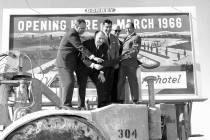Judge’s duty to sit still knows no contribution limits
Rejection isn't easy to take. There's serious grumbling about the rejection of two recommendations from the Nevada Judicial Code Commission by the Nevada Supreme Court.
One sounds queenly: the duty to sit. It is a controversial legal doctrine outlining when judges should disqualify themselves from hearing a case.
The other involves filthy lucre, commonly known as campaign dollars. The question is: When does a single contributor to a judicial campaign donate so much the judge can no longer be viewed as impartial?
The commission said $50,000 is too much. The court refused to set any limits.
Professor Jeffrey Stempel of the Boyd School of Law at the University of Nevada, Las Vegas was one commissioner who said not adopting the commission's recommendations on those two points was a missed opportunity.
"They backed away from the opportunity to strike a blow for greater judicial impartiality," Stempel said.
"The duty to sit is dead, disallowed, disliked by the legal profession as a whole for 35 years," Stempel said. "Our view was, if the case was close, a judge shouldn't sit."
The rule was, and essentially remains, that there's a duty to sit on a case when the area is gray. The idea was originally popular because many judges were ducking cases involving powerful litigants.
Stempel argued that in a case where someone believes there is bias, it's better to disqualify voluntarily.
He knows of at least two commissioners who are deeply disturbed by the court's rejection.
An 18-member commission that had a broad philosophical spectrum approved all the recommendations unanimously. They approved repealing the duty to sit doctrine, and suggested if $50,000 came from one source during an election cycle, even checks bundled from related companies or one law firm, that meant a judge should be disqualified.
Nevada Supreme Court Justice Jim Hardesty, speaking for himself, explained why there were problems with changing "duty to sit" in the code: It might overturn prior legal decisions. By changing the duty to sit doctrine, it would have been in direct conflict with prior decisions.
"If the duty to sit is to be revisited, it is best revisited through new cases that come in front of the court," Hardesty said.
The issue of campaign limits leading to disqualification "is a work in progress," Hardesty said. "Just because the court didn't act on it, doesn't mean it doesn't have to be monitored.
"While I respect the work of the commission, those recommendations amount to killing a fly with a sledgehammer," Hardesty said Friday.
The chairman of the commission, former Justice Bill Maupin, now an attorney by choice, took a moderate approach. "Reasonable minds can differ as to whether the court should have accepted the two."
It wouldn't have been a mistake to accept both of the rejected recommendations, Maupin said. But he and another commissioner who didn't want to be quoted by name weren't devastated by the court's rejection of the two concepts, as a few others were.
From the cynical outside looking in, it appears the justices didn't want to hurt their fundraising by setting a $50,000 cap from one bundled source.
The commissioners and the justices hope the revised code, which has many strengths as I outlined Saturday, would help the public have more confidence in judges. Some judges seem to be scorned, especially in the aftermath of the 2006 Los Angeles Times series "Juice vs. Justice," which portrayed Nevada judges in an unsavory light.
Hardesty presents a decent argument about using cases coming before the court to change standards governing impartiality of a judge.
Now that they are on notice that the court needs a case, attorneys should be more diligent about tracking how much the other side gave the judge. Except in this tightwad year, it's unlikely such a case will surface.
Jane Ann Morrison's column appears Monday, Thursday and Saturday. E-mail her at Jane@reviewjournal.com or call 702- 383-0275. She also blogs at lvrj.com/blogs/morrison.

















